Enhancement of Luminance in Powder Electroluminescent Devices by Substrates of Smooth and Transparent Cellulose Nanofiber Films
Abstract
1. Introduction
2. Materials and Methods
2.1. Materials
2.2. Characterization of the Substrate Films
2.3. Fabrication of the EL Devices
2.4. EL Measurements
3. Results and Discussion
4. Conclusions
Supplementary Materials
Author Contributions
Funding
Acknowledgments
Conflicts of Interest
References
- Brubaker, C.D.; Newcome, K.N.; Jennings, G.K.; Adams, D.E. 3D-Printed alternating current electroluminescent devices. J. Mater. Chem. C 2019, 7, 5573–5578. [Google Scholar] [CrossRef]
- Liu, D.; Ren, J.; Wang, J.; Xing, W.; Qian, Q.; Chen, H.; Zhou, N. Customizable and stretchable fibre-shaped electroluminescent devices via mulitcore-shell direct ink writing. J. Mater. Chem. C 2020, 8, 15092–15098. [Google Scholar] [CrossRef]
- Ohsawa, M.; Hashimoto, N.; Takeda, N.; Tsuneyasu, S.; Satoh, T. Flexible powder electroluminescent device on transparent electrode of printed invisible silver-grid laminated with conductive polymer. Flex. Print. Electron. 2020, 5, 025004. [Google Scholar] [CrossRef]
- Ohsawa, M.; Hashimoto, N.; Takeda, N.; Tsuneyasu, S.; Satoh, T. Bending reliability of transparent electrode of printed invisible silver-grid/PEDOT:PSS on flexible epoxy film substrate for powder electroluminescent device. Microelectron. Reliab. 2020, 109, 113673. [Google Scholar] [CrossRef]
- Yang, C.H.; Chen, B.; Zhou, J.; Chen, Y.M.; Suo, Z. Electroluminescence of giant stretchability. Adv. Mater. 2016, 28, 4480–4484. [Google Scholar] [CrossRef]
- Hu, D.; Xu, X.; Miao, J.; Gidron, O.; Meng, H. A Stretchable Alternating Current Electroluminescent Fiber. Materials 2018, 11, 184. [Google Scholar] [CrossRef] [PubMed]
- En-On, J.; Tuantranont, A.; Kerdcharoen, T.; Wongchoosuk, C. Flexible alternating current electroluminescent ammonia gas sensor. RSC Adv. 2017, 7, 16885–16889. [Google Scholar] [CrossRef]
- Seekaew, Y.; Wongchoosuk, C. A novel graphene-based electroluminescent gas sensor for carbon dioxide detection. Appl. Surf. Sci. 2019, 479, 525–531. [Google Scholar] [CrossRef]
- He, Y.; Zhang, M.; Zhang, N.; Zhu, D.; Huang, C.; Kang, L.; Zhang, J. Paper-Based ZnS: Cu Alternating Current Electroluminescent Devices for Current Humidity Sensors with High-Linearity and Flexibility. Sensors 2019, 19, 4607. [Google Scholar] [CrossRef] [PubMed]
- Tsuneyasu, S.; Takeda, N.; Satoh, T. Novel powder electroluminescent device enabling control of emission color by thermal response. J. Soc. Inf. Disp. 2021, 29, 207–212. [Google Scholar] [CrossRef]
- Liang, G.; Liu, Z.; Mo, F.; Tang, Z.; Li, H.; Wang, Z.; Sarangi, V.; Pramanick, A.; Fan, J.; Zhi, C. Self-healable electroluminescent devices. Light. Sci. Appl. 2018, 7, 1–11. [Google Scholar] [CrossRef] [PubMed]
- Park, H.J.; Kim, S.; Lee, J.H.; Kim, H.T.; Seung, W.; Son, Y.; Kim, T.Y.; Khan, U.; Park, N.M.; Kim, S.W. Self-powered motion-driven triboelectric electroluminescence textile system. ACS Appl. Mater. Interfaces 2019, 11, 5200–5207. [Google Scholar] [CrossRef]
- Shin, Y.B.; Ju, Y.H.; Lee, H.J.; Han, C.J.; Lee, C.R.; Kim, Y.; Kim, J.W. Self-Integratable, Healable and Stretchable Electroluminescent Device Fabricated via Dynamic Urea Bonds Equipped in Polyurethane. ACS Appl. Mater. Interfaces 2020, 12, 10949–10958. [Google Scholar] [CrossRef]
- Lee, S.; Kang, T.; Lee, W.; Afandi, M.M.; Ryu, J.; Kim, J. Multifunctional device based on phosphor-piezoelectric PZT: Lighting, speaking, and mechanical energy harvesting. Sci. Rep. 2018, 8, 1–7. [Google Scholar] [CrossRef]
- Kim, J.S.; Cho, S.H.; Kim, K.L.; Kim, G.; Lee, S.W.; Kim, E.H.; Jeong, B.; Hwang, I.; Han, H.; Shim, W.; et al. Flexible artificial synesthesia electronics with sound-synchronized electroluminescence. Nano Energy 2019, 59, 773–783. [Google Scholar] [CrossRef]
- Cho, S.; Kang, D.H.; Lee, H.; Kim, M.P.; Kang, S.; Shanker, R.; Ko, H. Highly Stretchable Sound-in-Display Electronics Based on Strain-Insensitive Metallic Nanonetworks. Adv. Sci. 2020, 8, 2001647. [Google Scholar] [CrossRef] [PubMed]
- Sandanayaka, A.S.D.; Matsushima, T.; Bencheikh, F.; Terakawa, S.; Potscavage, W.J.P., Jr.; Qin, C.; Fujihara, T.; Goushi, K.; Ribierre, J.-C.; Adachi, C. Indication of current-injection lasing from an organic semiconductor. Appl. Phys. Express 2019, 12, 061010. [Google Scholar] [CrossRef]
- Moshaev, V.; Leibin, Y.; Malka, D. Optimizations of Si PIN diode phase-shifter for controlling MZM quadrature bias point using SOI rib waveguide technology. Opt. Laser Technol. 2021, 138, 106844. [Google Scholar] [CrossRef]
- Malka, D. A Four Green TM/Red TE Demultiplexer Based on Multi Slot-Waveguide Structures. Materials 2020, 13, 3219. [Google Scholar] [CrossRef] [PubMed]
- Nabesaka, K.; Ishikawa, Y.; Hosokawa, Y.; Uraoka, Y. Photomechanical modification of ZnS microcrystal to enhance electroluminescence by ultrashort-pulse laser processing. Appl. Phys. Express. 2017, 10, 021201. [Google Scholar] [CrossRef]
- Tan, Y.J.; Godaba, H.; Chen, G.; Tan, S.T.M.; Wan, G.; Li, G.; Lee, P.M.; Cai, Y.; Li, S.; Shepherd, R.F.; et al. A transparent, self-healing and high-κ dielectric for low-field-emission stretchable optoelectronics. Nat. Mater. 2020, 19, 182–188. [Google Scholar] [CrossRef] [PubMed]
- Satoh, T.; Nakatsuta, T.; Tsuruya, K.; Tabata, Y.; Tamura, T.; Ichikawa, Y.; Tango, H. Electrical properties of two-sided luminescence powder-distributed inorganic electroluminescence panels. J. Mater. Sci. Mater. Electron. 2007, 18, 239–242. [Google Scholar] [CrossRef]
- Kim, J.-Y.; Bae, M.J.; Park, S.H.; Jeong, T.; Song, S.; Lee, J.; Han, I.; Yoo, J.B.; Jung, D.; Yu, S. Electroluminescence enhancement of the phosphor dispersed in a polymer matrix using the tandem structure. Org. Electron. 2011, 12, 529–533. [Google Scholar] [CrossRef]
- Takeda, N.; Tsuneyasu, S.; Satoh, T. EL emission enhancement in powder electroluminescent device via insertion of receptive layer. Electron. Lett. 2020, 56, 147. [Google Scholar] [CrossRef]
- Kim, J.-Y.; Park, S.H.; Jeong, T.; Bae, M.J.; Song, S.; Lee, J.; Han, I.T.; Jung, D.; Yu, S. Paper as a Substrate for Inorganic Powder Electroluminescence Devices. IEEE Trans. Electron Devices 2010, 57, 1470–1474. [Google Scholar] [CrossRef]
- Sloma, M.; Janczak, D.; Wroblewski, G.; Mlozniak, A.; Jakubowska, M. Electroluminescent structures printed on paper and textile elastic substrates. Circuit World 2014, 40, 13–16. [Google Scholar] [CrossRef]
- Yakoh, A.; Siangproh, W.; Chailapakul, O.; Ngamrojanavanich, N. Optical Bioelectronic Device Based on a Screen-Printed Electroluminescent Transducer. ACS Appl. Mater. Interfaces 2020, 12, 22543–22551. [Google Scholar] [CrossRef] [PubMed]
- Fukuzumi, H.; Saito, T.; Iwata, T.; Kumamoto, Y.; Isogai, A. Transparent and High Gas Barrier Films of Cellulose Nanofibers Prepared by TEMPO-Mediated Oxidation. Biomacromolecules 2009, 10, 162–165. [Google Scholar] [CrossRef]
- Nogi, M.; Iwamoto, S.; Nakagaito, A.N.; Yano, H. Optically Transparent Nanofiber Paper. Adv. Mater. 2009, 21, 1595–1598. [Google Scholar] [CrossRef]
- Nogi, M.; Kim, C.; Sugahara, T.; Inui, T.; Takahashi, T.; Suganuma, K. High thermal stability of optical transparency in cellulose nanofiber paper. Appl. Phys. Lett. 2013, 102, 181911. [Google Scholar] [CrossRef]
- Rodionova, G.; Eriksen, Ø.; Gregersen, Ø. TEMPO-oxidized cellulose nanofiber films: Effect of surface morphology on water resistance. Cellulose 2012, 19, 1115–1123. [Google Scholar] [CrossRef]
- Nakagaito, A.N.; Iwamoto, S.; Yano, H. Bacterial cellulose: The ultimate nano-scalar cellulose morphology for the production of high-strength composites. Appl. Phys. A Mater. Sci. Process. 2005, 80, 93–97. [Google Scholar] [CrossRef]
- Henriksson, M.; Berglund, L.A.; Isaksson, P.; Lindström, T.; Nishino, T. Cellulose nanopaper structures of high toughness. Biomacromolecules 2008, 9, 1579–1585. [Google Scholar] [CrossRef]
- Nogi, M.; Abe, K.; Handa, K.; Nakatsubo, F.; Ifuku, S.; Yano, H. Property enhancement of optically transparent bionanofiber composites by acetylation. Appl. Phys. Lett. 2006, 89, 233123. [Google Scholar] [CrossRef]
- Uetani, K.; Okada, T.; Oyama, H.T. In-Plane Anisotropic Thermally Conductive Nanopapers by Drawing Bacterial Cellulose Hydrogels. ACS Macro Lett. 2017, 6, 345–349. [Google Scholar] [CrossRef]
- Wise, L.E. Chlorite holocellulose, its fractionation and bearing in summative wood analysis and on studies in hemicellulose. Pap. Trade J. 1946, 122, 35–43. [Google Scholar]
- Isogai, A.; Saito, T.; Fukuzumi, H. TEMPO-oxidized cellulose nanofibers. Nanoscale 2011, 3, 71–85. [Google Scholar] [CrossRef]
- Okita, Y.; Saito, T.; Isogai, A. Entire Surface Oxidation of Various Cellulose Microfibrils by TEMPO-Mediated Oxidation. Biomacromolecules 2010, 11, 1696–1700. [Google Scholar] [CrossRef] [PubMed]
- Saito, T.; Isogai, A. TEMPO-Mediated Oxidation of Native Cellulose. The Effect of Oxidation Conditions on Chemical and Crystal Structures of the Water-Insoluble Fractions. Biomacromolecules 2004, 5, 1983–1989. [Google Scholar] [CrossRef]
- Uetani, K.; Okada, T.; Oyama, H.T. Crystallite Size Effect on Thermal Conductive Properties of Nonwoven Nanocellulose Sheets. Biomacromolecules 2015, 16, 2220–2227. [Google Scholar] [CrossRef]
- Uetani, K.; Hatori, K. Thermal conductivity analysis and applications of nanocellulose materials. Sci. Technol. Adv. Mater. 2017, 18, 877–892. [Google Scholar] [CrossRef] [PubMed]
- Wang, S.G.; Zhang, Q.; Yoon, S.F.; Ahn, J.; Wang, Q.; Yang, D.J.; Zhou, Q.; Yue, N.L. Optical properties of nano-crystalline diamond films deposited by MPECVD. Opt. Mater. 2003, 24, 509–514. [Google Scholar] [CrossRef]
- Ji, J.; Perepichka, I.F.; Bai, J.; Hu, D.; Xu, X.; Liu, M.; Wang, T.; Zhao, C.; Meng, H.; Huang, W. Three-phase electric power driven electoluminescent devices. Nat. Commun. 2021, 12, 1–11. [Google Scholar]
- Kim, J.Y.; Jeong, T.; Park, S.H.; Bae, M.J.; Song, S.; Lee, J.; Han, I.; Jung, D.; Liu, C.; Yu, S.G. Enhanced optical and electrical properties of inorganic electroluminescent devices using the top-emission structure. Jpn. J. Appl. Phys. 2011, 50, 06GF06. [Google Scholar] [CrossRef]
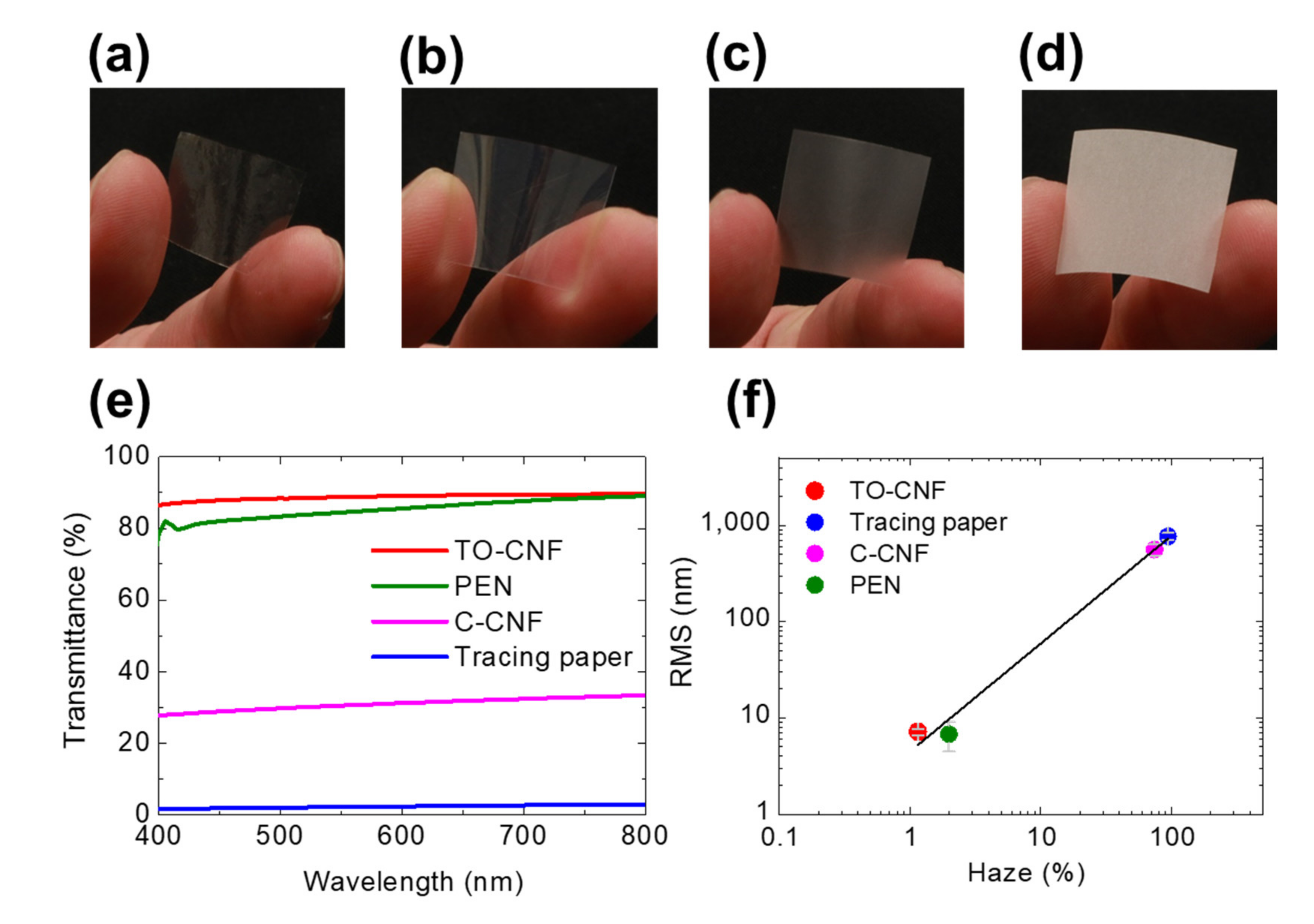
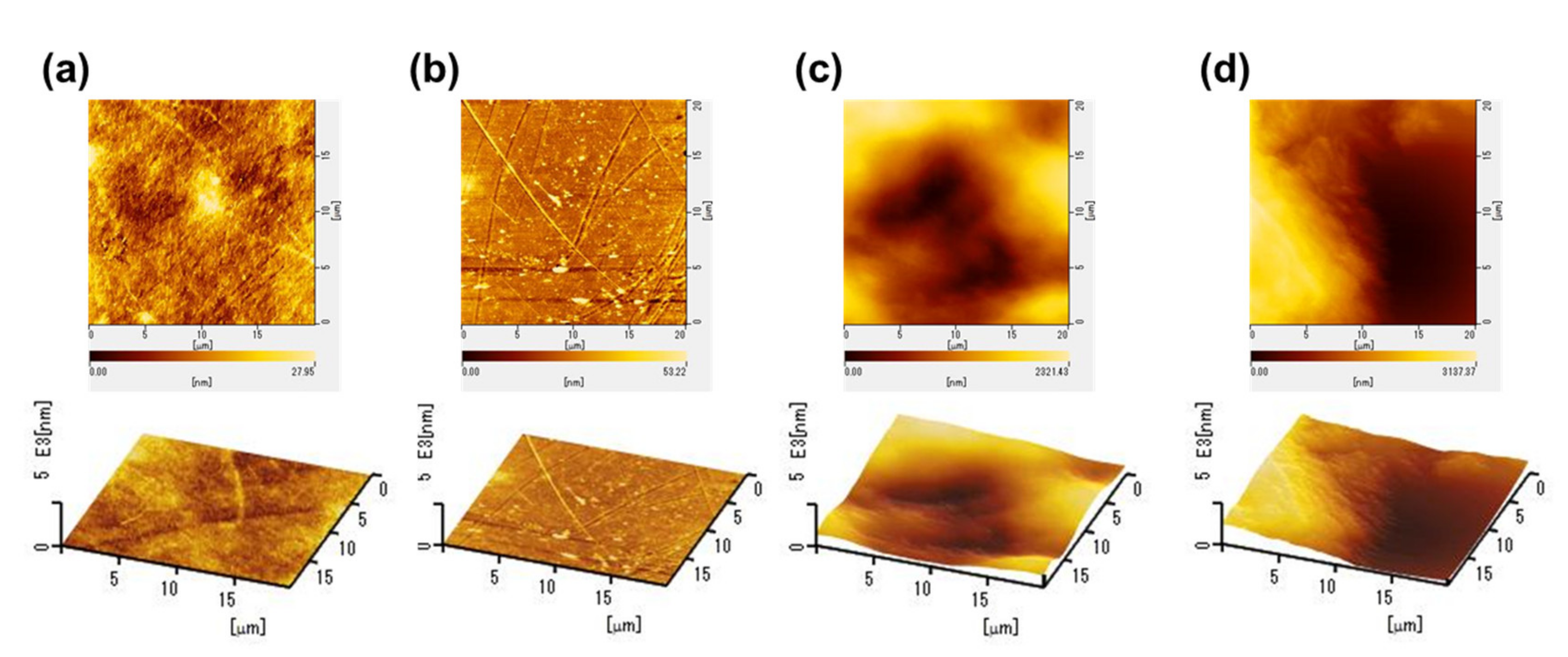
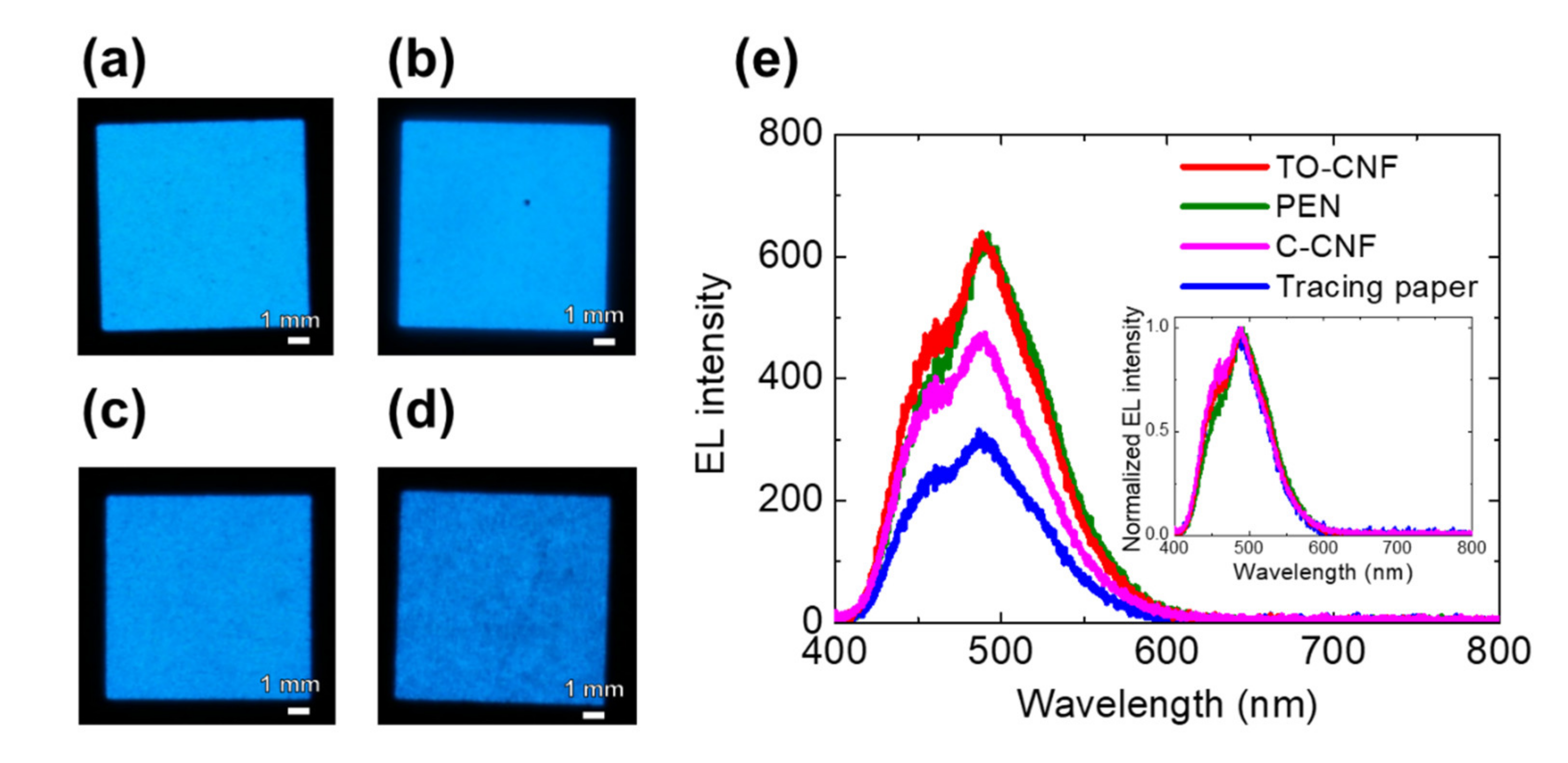
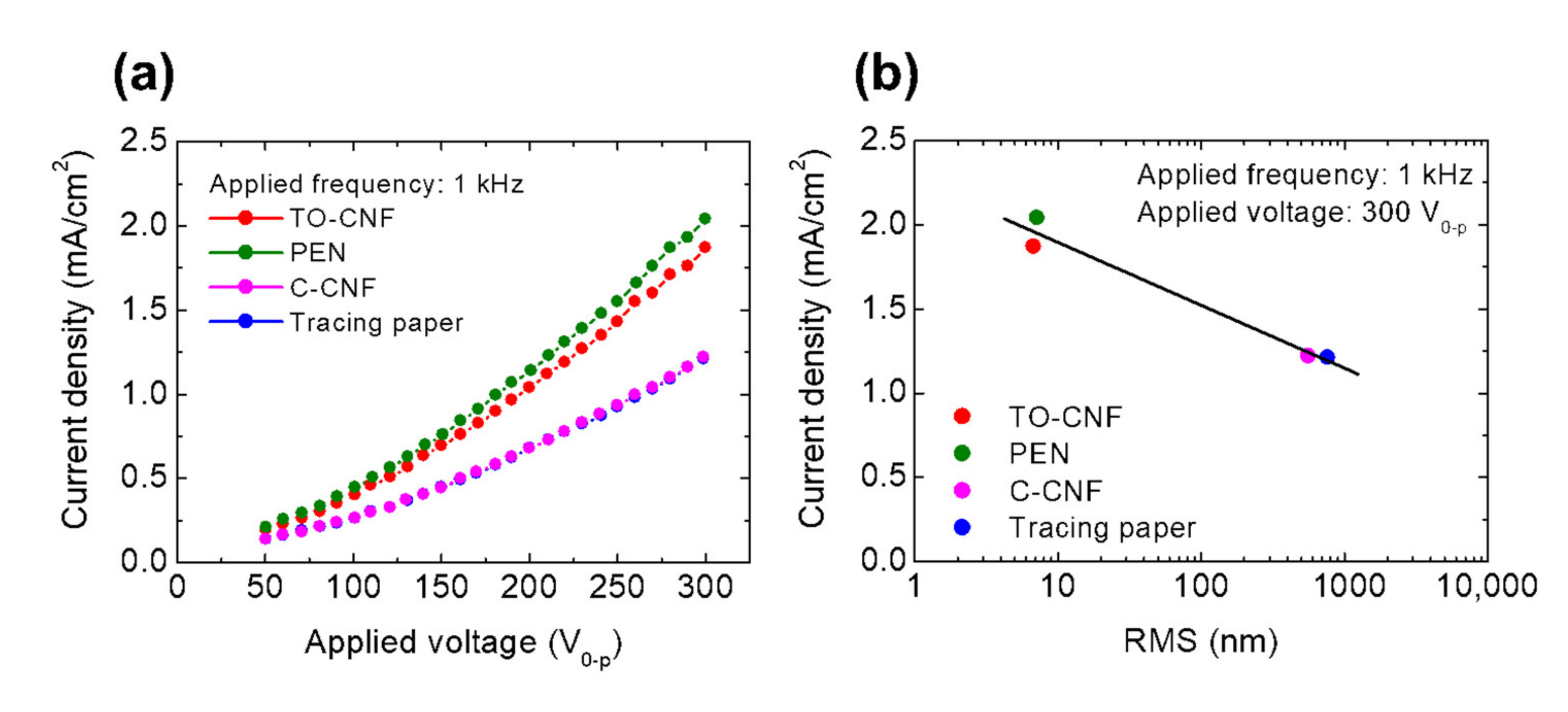
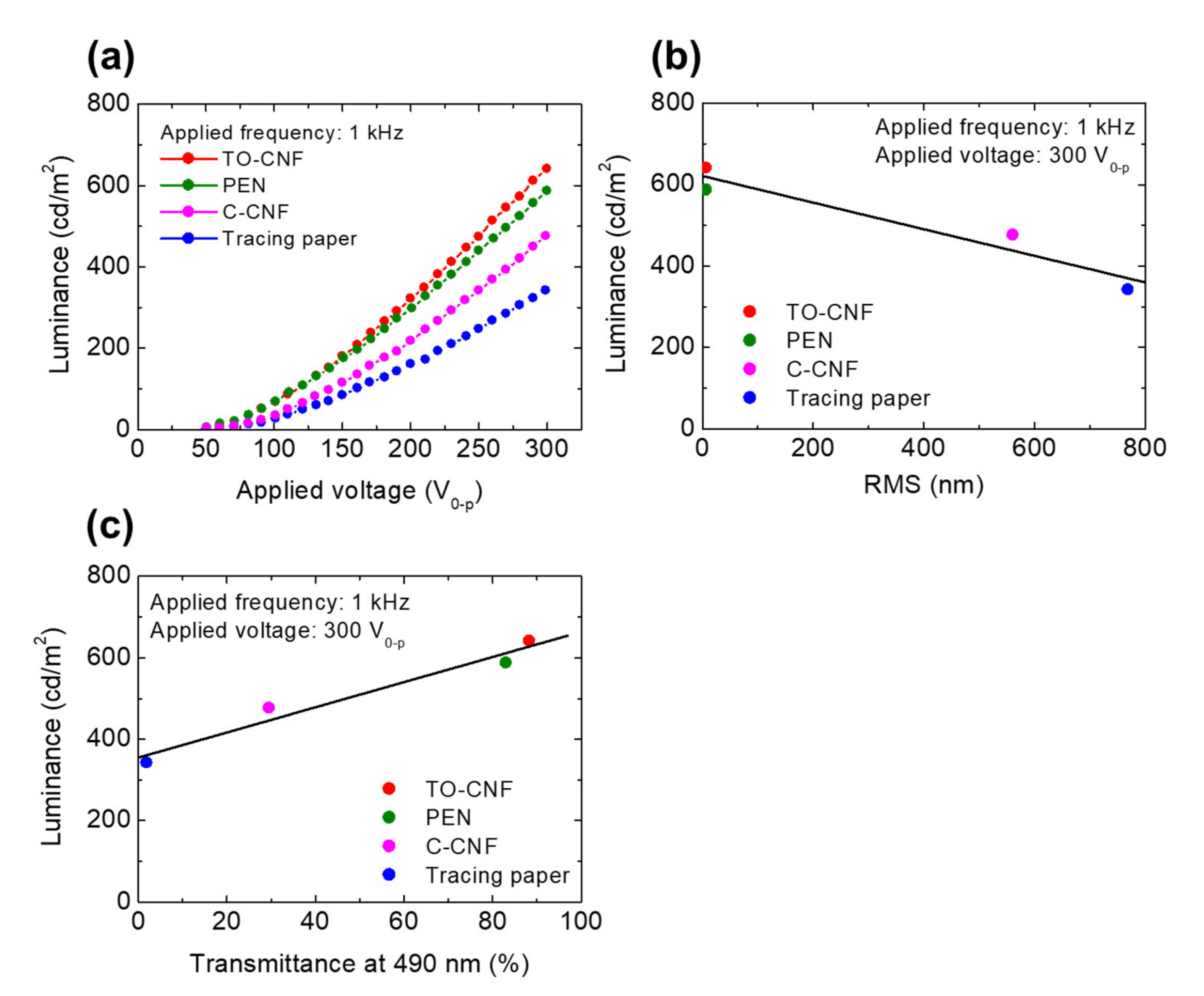
| Film Thickness (μm) | RMS Roughness (nm) | Haze (%) | Thickness of the Functional Layers (μm) | |
|---|---|---|---|---|
| TO-CNF | 22.0 ± 2.0 | 6.78 ± 2.3 | 1.99 ± 0.06 | 106.0 ± 2.3 |
| PEN | 128.0 ± 2.8 | 7.19 ± 0.54 | 1.15 ± 0.10 | 129.4 ± 3.8 |
| C-CNF | 54.0 ± 0.4 | 560.9 ± 72.7 | 74.34 ± 0.41 | 94.0 ± 3.6 |
| Tracing paper | 82.0 ± 1.4 | 769 ± 64.5 | 93.96 ± 0.04 | 122.6 ± 6.7 |
Publisher’s Note: MDPI stays neutral with regard to jurisdictional claims in published maps and institutional affiliations. |
© 2021 by the authors. Licensee MDPI, Basel, Switzerland. This article is an open access article distributed under the terms and conditions of the Creative Commons Attribution (CC BY) license (http://creativecommons.org/licenses/by/4.0/).
Share and Cite
Tsuneyasu, S.; Watanabe, R.; Takeda, N.; Uetani, K.; Izakura, S.; Kasuya, K.; Takahashi, K.; Satoh, T. Enhancement of Luminance in Powder Electroluminescent Devices by Substrates of Smooth and Transparent Cellulose Nanofiber Films. Nanomaterials 2021, 11, 697. https://doi.org/10.3390/nano11030697
Tsuneyasu S, Watanabe R, Takeda N, Uetani K, Izakura S, Kasuya K, Takahashi K, Satoh T. Enhancement of Luminance in Powder Electroluminescent Devices by Substrates of Smooth and Transparent Cellulose Nanofiber Films. Nanomaterials. 2021; 11(3):697. https://doi.org/10.3390/nano11030697
Chicago/Turabian StyleTsuneyasu, Shota, Rikuya Watanabe, Naoki Takeda, Kojiro Uetani, Shogo Izakura, Keitaro Kasuya, Kosuke Takahashi, and Toshifumi Satoh. 2021. "Enhancement of Luminance in Powder Electroluminescent Devices by Substrates of Smooth and Transparent Cellulose Nanofiber Films" Nanomaterials 11, no. 3: 697. https://doi.org/10.3390/nano11030697
APA StyleTsuneyasu, S., Watanabe, R., Takeda, N., Uetani, K., Izakura, S., Kasuya, K., Takahashi, K., & Satoh, T. (2021). Enhancement of Luminance in Powder Electroluminescent Devices by Substrates of Smooth and Transparent Cellulose Nanofiber Films. Nanomaterials, 11(3), 697. https://doi.org/10.3390/nano11030697






